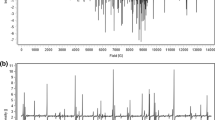Abstract
RECENT publications of Commoner, Townsend and Pake1 and Truby and Goldzieher2 have shown the value of electron-spin resonance studies in detecting the presence of free radicals in biological tissues. During the course of a survey of free radicals in biological tissues we noted that two tissues in particular gave strong signals. These were seeds of Allium cepa, the onion, and larvæ and adults from Calliphora vomitoria, the blow fly.
Similar content being viewed by others
References
Commoner, B., Townsend, J., and Pake, G., Nature, 174, 689 (1954).
Truby, F., and Goldzieher, J., Nature, 182, 1371 (1958).
Author information
Authors and Affiliations
Rights and permissions
About this article
Cite this article
EDWARDS, M., KERKUT, G., MUNDAY, K. et al. Electron Spin Resonance Investigations of Allium cepa, and Calliphora vomitoria . Nature 184, 1402–1403 (1959). https://doi.org/10.1038/1841402a0
Issue Date:
DOI: https://doi.org/10.1038/1841402a0
- Springer Nature Limited





